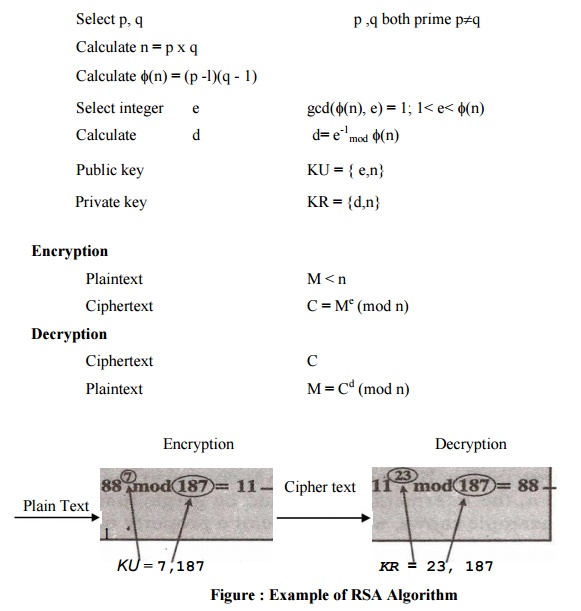Chapter: Cryptography and Network Security
RSA Algorithm
RSA Algorithm
It was
developed by Rivest, Shamir and Adleman. This algorithm makes use of an
expression with exponentials. Plaintext is encrypted in blocks, with each block
having a binary value less than some number n. That is, the block size must be
less than or equal to log2 (n); in practice, the block size is
k-bits, where 2k < n < 2k+1. Encryption
and decryption are of the following form, for some plaintext block M and
ciphertext block C:
C = Me
mod n
= Cd
mod n = (Me mod n) mod n
(Me)
d mod n
= Med
mod n
Both the
sender and receiver know the value of n. the sender knows the value of e and
only the receiver knows the value of d. thus, this is a public key encryption
algorithm with a public key of KU = {e, n} and a private key of KR = {d, n}.
For this algorithm to be satisfactory for public key encryption, the following
requirements must be met:
·
It is possible to find values of e, d, n such that
Med = M mod n for all M<n.
·
It is relatively easy to calculate Me
and Cd for all values of M<n.
·
It is infeasible to determine d given e and n.
Let us
focus on the first requirement. We need to find the relationship of the form:
Med = M mod n
A
corollary to Euler‟s theorem fits t0068e bill: Given two prime numbers p and q
and two integers, n and m, such that n=pq and 0<m<n, and arbitrary
integer k, the following relationship holds
mkФ(n) +1 =
mk(p-1)(q-1) +1 = m mod n
where
Ф(n) – Euler totient function, which is the number of positive integers less
than n and relatively prime to n. we can achieve the desired relationship, if
ed=kФ(n)+1
This is
equivalent to saying:
ed ≡ 1 mod Ф(n) d = e-1
mod Ф(n)
That is,
e and d are multiplicative inverses mod Ф(n). According to the rule of modular
arithmetic, this is true only if d (and therefore e) is relatively prime to
Ф(n). Equivalently,
gcd(Ф(n), d) = 1.
The steps
involved in RSA algorithm for generating the key are
·
Select two prime numbers, p = 17 and q = 11.
·
Calculate n = p*q = 17*11 = 187
·
Calculate Ф(n) = (p-1)(q-1) = 16*10 = 160.
·
Select e such that e is relatively prime to Ф(n) =
160 and less than Ф(n); we choose e = 7.
·
Determine d such that ed ≡ 1 mod Ф(n) and d<160.
the correct value is d = 23, because
23*7 =
161 = 1 mod 160.
1. The RSA algorithm:
Key Generation

2. Security of RSA
There are
three approaches to attack the RSA:
·
brute force key search (infeasible given size of
numbers)
·
mathematical attacks (based on difficulty of
computing ø(N), by factoring modulus N)
· timing
attacks (on running time of decryption)
Factoring Problem
Mathematical
approach takes 3 forms:
·
Factor n = p*q, hence find Ф(n) and then d.
·
Determine Ф(n)directly without determining p and q
and find d.
·
Find d directly, without first determination Ф(n).
Timing attacks
It has
been proved that the opponent can determine a private key by keeping track of
how long a computer takes to decipher messages. Although the timing attack is a
serious threat, there are simple countermeasures that can be used:
·
Constant exponentiation time – ensures that all
exponentiations take the same amount of time before returning a result.
·
Random delay – better performance could be achieved
by adding a random delay to the exponentiation algorithm to confuse the timing
attack.
·
Blinding – multiply the ciphertext by a random
number before performing exponentiation.
Related Topics